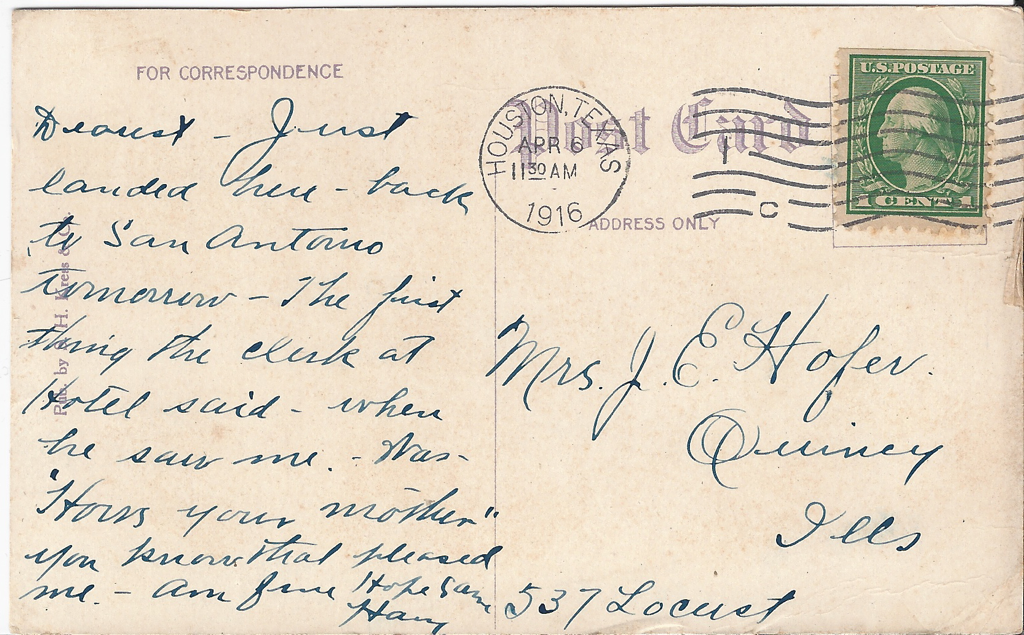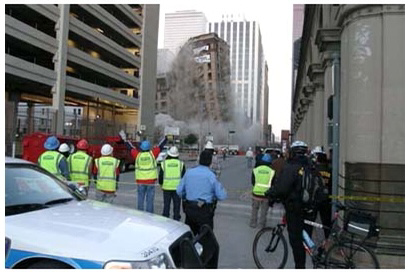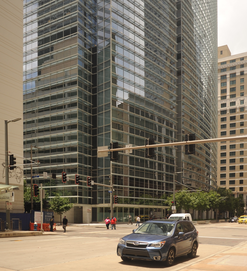Cotton Hotel
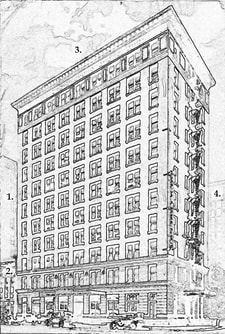
6 April 1916: When Harry Hofer wrote his postcard from the Cotton Hotel, the block on Fannin between Rusk and Walker was filled with new construction. Four years earlier on May 19, 1912, one of Houston's most devastating fires destroyed the southeast corner of Capitol and Main one block north. Lost in the conflagration was the Stowers Furniture Building. The owners chose to relocate to Fannin at Walker where they built a 10 story building in 1913 seen here on the left. That same year the Cotton Hotel was also built on the opposite corner of Fannin at Rusk. 1. 820 Fannin: Stowers Furniture, 10 floors, 1913; 2. 810-812 Fannin: Sandwiched between the Stowers Furniture and the Cotton Hotel was a three story building holding the barber shop and tailor business of the Vester Family. William Vesper (1853-1934) came to America from Germany in 1882 with his wife and two daughters. Settling first in Clay County, IN where children William Louis (b. 1884), Jacob (1888), Frederick (1889) and Sophia (1891) were born, the family moved to Wharton County, TX before 1910 to try their hand at truck farming. The eldest son, William Louis, moved to Saint Louis about this time, remaining there through about 1917. The family then converged to Houston and established a barber shop in the Cotton Hotel and adjacent building, with Louis Jacob practicing there as a tailor. Later the Vespers took over the Rusk Hotel at 909 Rusk as Jacob moved to Los Angeles where he remained. Many of the Houston Vesper family members are buried in Washington (German) Cemetery on Washington Avenue; 3. 804 Fannin: Cotton Hotel, 11 floors, 1913; 4. 806 Main: The Carter Building, 17 stories, 1910.
|
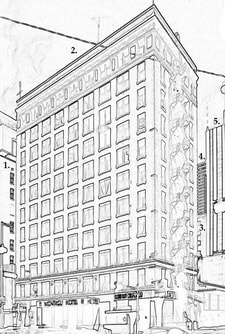
10 July 2004: 1. 820 Fannin: Stowers Furniture, 10 floors, 1913 (now Aloft Hotel); 2. 804 Fannin: Montague Hotel (Cotton Hotel), 11 floors, 1913, here grown rather derelict (note the burned out room on the eighth floor); 3. 812 Main: Battlestein's Building, long vacant but now a residential condominium building, 10 floors, 1923; 4. 910 Louisiana: One Shell Plaza, 50 floors, 1971; 5. 806 Main: First National Life Building (Carter Building), here showing the cladding added in 1969 to “modernize” the structure, 23 floors, 1910.
As a part of a redevelopment of the entire block bounded by Rusk, Fannin, Walker, and Main, the Montague Hotel building was imploded 20 January 2008 while the Beatty-West Building had been taken down more slowly in December 2007. Construction was then free to begin on the BG Group Place (MainPlace, Block 93) which would rise to 46 floors by 2011. Historic Stowers Furniture building was not demolished for the project and after a renovation was opened in 2016 as the Aloft Houston Downtown. Soon after the vertical cladding on the Carter Building was removed in a renovation 2012/2014, recreating the original facade for the JW Mariott Houston Hotel. The neighborhood is now one of finest districts in downtown Houston, with the curved glass front of BG Place on Rusk Street defying the rigid downtown grid, and the setback portion of the 39th - 43rd floors facing southeast providing a unique profile on the skyline. |
|
Postmarked: 6 April 1916; Houston, Texas “C”
Stamp” 1c Green George Washington #405 To: Mrs. J. E. Hofer. Quincy Ills 537 Locust Message: Dearest – Just landed here – back to San Antonio tomorrow – The first thing the clerk at the hotel said – when he saw me, Was, “How’s your mother” You know that pleased me. – Am fine Hope same Harry Harry addresses his mother with great affection, and evidently had stayed at the Cotton Hotel before and mentioned his mother to the clerk. She was widowed four years earlier, and he may have been worried about her health as well, which may have been poor. Indeed, she did not live much more than a year, and died on 2 July 1917 at the age of 70. Her name was Gertrude Jost Hofer, daughter of Jacob Jost and Gertrude Schmitt, who immigrated to Quincy, Adams County, IL from Hessen, Germany in 1837. In 1849 they fell victim to a Cholera epidemic, leaving Gertrude to be raised by an Uncle, her mother’s brother, Leonard Schmitt.
At the age of 20 Gertrude Jost married John Ernst Hofer in Adams County, IL, and they began to have a family: Gertrude (1868), Aletha (1871), and Harry (1875). Aletha died in 1892 at 21, never having married; Gertrude married Charles Wesley Allen and raised a single child, Gertrude (b. 1893), in the Hofer house [three Gertrudes!] at 537 Locust in Quincy, Ill. Harry remained single and began to sell insurance with a partner, Oscar William Shannon (1884-1964). He had long been attracted to the lure of recreation and the entertainment industry, and from 1912 he managed the local baseball team, The Quincy Gems, but his partner Oscar took over the team in 1915, preserving local participation in minor baseball for the Three-I League (Illinois-Indiana-Iowa). For 25 years Harry was treasurer of the Empire Theatre, and was involved in the operation of Highland, an amusement park with skating rink, saloon, theatre adjacent to the baseball fields. In the period in which he wrote the postcard, Harry was advance agent for Worsham shows, a carnival company, which required him to travel across the county. He became a familiar face in hotels from Los Angeles (Continental Hotel), San Antonio, and Houston (Cotton Hotel). |
Harry’s interest in the entertainment no doubt found its origin in his youth. Harry’s father, John Ernst Hofer (1846-1912) had been a music teacher in Quincy. J. E. Hofer came to America at the age of 12, coming to New York City from Bavaria in 1857 on the ship Reinhard with his father George Hofer (physician) and sisters, Sophy (19) and Emyly (17). They settled first in Reading, Berks County, PA in 1860 where George worked in a restaurant, and perhaps it was there that Ernst learned to love music. Before 1870 the family moved to Red Bud, Randolph County, IL 40 miles southeast of Saint Louis, MO. His sister Emilie settled there and married Wilhelm Fischer, and there George Ernst Hoefer died in 1875 and is buried in St. John’s Lutheran Cemetery, where his daughter Emilie Fischer joined him in 1917. Sophy succumbed to mental illness and died in the poor farm in Adams County, IL some time after 1880. Johan Ernst settled in Quincy quite early, married Gertrude Jost in 1867 and had their small family; he taught music and they lived at 537 Locust as early as 1884.
Harry’s peripatetic life came to an end in 1922 at the age of 47 when he married a widow, Laura Jarrard Boykin originally from Beaumont, with two nearly grown children: Mary Jarrard (b. 1904) and Emily (1910). Her husband, Henry Semple Boykin (1874-1918), died of the influenza epidemic on October 12, 1918 at the height of the epidemic. Henry worked for an east Texas lumber company, Chicago Lumber and Coal Company, managed by his brother Lorenzo James Boykin (1878-1948). Harry Hofer moved his new family back to Quincy, IL where he returned to the insurance business and the entertainment industry. Harry and Laura had no children of their own, and Laura’s children would soon be out on their own. Mary married Bennett W. Bartlett (1889-1977), a WWI veteran and civil engineer who would work for the Quincy Water Works. Emily (1909-1946) married Ross W. Dickson in Quincy, from whom she would divorce in 1938 and marry Prescott. Harry died in 1944 and was buried in Woodland Cemetery in Quincy near his parents and sister. Laura died in 1956 and was buried in the Boykin plot in Glenwood Cemetery in Houston near her husband and daughter Emily Prescott, who died in 1946 in Los Angeles. Mary Jarrard Bartlett died in 1988, and joined her husband Bennett W. Bartlett (1889-1977) and the rest of her family in Glenwood Cemetery under a vast spreading Live Oak tree. |
